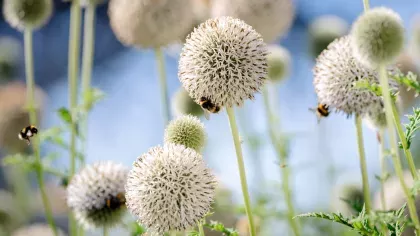27 March 2025
4 min read
Become a citizen scientist with Trees for Bees at Wakehurst
Help with our scientific research by counting pollinators at Wakehurst.

There are over 20,000 different species of bee around the world, and 270 in the UK but wild bee populations are in decline.
You can help our scientists research which plants and trees our pollinators prefer with our Trees for Bees trail, app and download. This information will help inform urban landscape planning, ensuring green spaces are designed to attract pollinators to bring the buzz back to our environments.

1. Download the app
The Trees for Bees app includes an interactive map of all the trees included in the study and a guide for identifying pollinators. Through it, you'll record all your findings by starting the in-app timer and logging the quantity of each pollinator you see. You won't need a pencil or paper, as the app keeps track of all your tallies. The app also saves all your previous counts, so you can compare your own data!
We recommend downloading the app ahead of your visit, as signal can be patchy across our landscape. You’ll be ready to go as soon as you step foot in the gardens!

2. Visit Wakehurst
Our free Trees for Bees trail runs at Wakehurst from March to September, and you can take part all day, every day! It's a great activity for children, to get budding ecologists engaged with and interested in protecting wildlife.
Why not become a member to enjoy unlimited entry, and see how our pollinators behave throughout the changing seasons?
If you’re part of a local charity or community group, join an Engagement Session to hear from the scientists themselves and benefit from assistance in using the app. We want to ensure that nobody faces barriers to engaging with nature and wildlife, so get in touch with wakehurstcommunity@kew.org if you think this might be for you.
3. Find a tree
Check our pollinators guide online ahead of your visit or pick up a copy when you arrive. This handy guide lays out the trees we’re studying and when you can expect them to be in flower.
When you’re in the gardens, use the interactive map to find their location in the gardens. You’ll find clusters of selected trees around the Water Gardens, Winter Garden into Bethlehem Wood, and around the top of Bloomers Valley.
Load up the app, log in the tree's details and you’re ready to start counting!


4. Know your pollinators
Our scientists are interested in all the trees’ visitors, whether that’s bees, wasps, hoverflies or anything else. Once you've selected your tree, use the app to start your timer and count the pollinators you see! Don’t worry if you don’t manage to spot anything on the tree; logging it in the app is still very helpful for our scientists. Below is some handy guidance on how to spot the different pollinators:
Honeybees
There is only one species of honeybee in the UK, and it is similar in size and shape to social wasps. They have a thick body covered in short but visible hairs, with a yellow and brown abdomen, and two pairs of wings that lay flat against their body when at rest.
Bumblebees
You’ll probably hear them before you see them, with their loud buzzing sound! At 8-30mm in size, they’re larger and rounder than other bees and can come in bright colours such as red, orange, yellow and white.
Solitary bees
They vary greatly in colour and size, from 2-12mm, and are usually hairy, with two pairs of wings.
Social wasps
Although similar in size and shape to a honeybee, they have no hairs and can be easily identified by their waxy bodies in bright yellow and black. Wasps can also be identified by their narrow ‘waist’ (the join between the thorax and abdomen), and long, thick antennae.
Hoverflies
Named after their ‘hovering’ movement, hoverflies have one pair of wings which don’t fold up, and short, stumpy antennae. Their large ‘fly’ eyes take up most of the head and can also be identified by their thick waist and bright markings.
Pollinators



5. Bring the science back to your garden
Want your own garden to be buzzing with bees? Watch our video below to learn how to create your very own pollinator-friendly garden.
Stop by the Plant Centre at Wakehurst after a day’s exploring to pick up all you need to transform your garden into a bee haven.
 (1).jpg.webp?itok=ySYfENvk)

